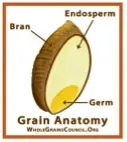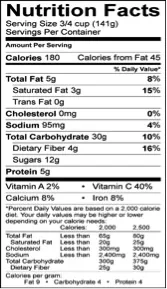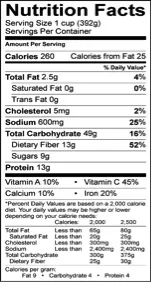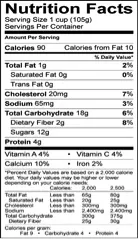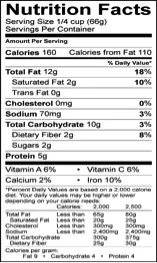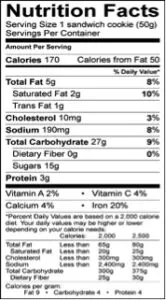9 Ways to Help Protect Your Heart Health

Despite the fact that breast cancer gets all the press, heart disease is actually the number 1 cause of death for American women, killing more each year than all types of cancer combined. In an effort to raise awareness about this often silent killer and to encourage all women to take their heart health seriously, the first week of February, from the 1st to the 7th, has been designated as Women’s Heart Health Week. This awareness campaign culminates on the 7th with the American Heart Association’s Wear Red Day.
Take some time this week to help raise the awareness of the women around you about their heart health and to talk about how every woman can work to protect the health of her heart.
As our contribution, here are 9 heart-healthy foods that can play a role in your efforts in prevent heart disease and delicious ways to incorporate them into your diet.
1. Oats
Whether you fill your breakfast bowl with oatmeal of enjoy a plate of Crunchy Apple Salad for lunch, getting oats in your diet is good for your heart. These wonder grains are full of omega-3 fatty acids, magnesium, potassium, folate, niacin, and soluble fiber.
2. Black or Kidney Beans
Great in chili or soup, these kinds of beans provide B-vitamins, niacin, folate, and fiber. Whip up some Corn and Black Bean Salsa for a heart healthy snack or as a terrific topping for beef, chicken, or fish.
3. Almonds
These tasty tree nuts provide vitamin E, magnesium, fiber, and heart-healthy fats. Grab a handful for a snack or mix them up in Orange Almond Salad for lunch or dinner.
4. Walnuts
Known for their earthy flavor, these nuts also make a great afternoon snack while providing fiber, folate, healthy fats, and omega-3s. Try the Wheat Farmer’s Salad for a filling lunch or a light dinner.
5. Brown Rice
Filled with B-vitamins, fiber, and magnesium, brown rice provides a heart healthy alternative to other grains. Serve it under steamed vegetables or use it to make Chicken and Rice Soup.
6. Blueberries
When it comes to heart-healthy, you don’t get much better than blueberries. They provide beat-carotene, calcium, magnesium, potassium, vitamin C, and fiber. They make a great topping for oatmeal or cereal in the morning, a great snack all by themselves, or you can bake them up in Blueberry Muffins for a special treat.
7. Carrots
Packed with alpha-carotene and full of fiber, carrots add a great crunch to everything you put them in. Slice them up in salad or put them on this Yummy Veggie Pizza for a dinner so delicious, everyone will love it.
8. Spinach
This leafy green gives you lutein, b-complex vitamins, magnesium, potassium, folate, calcium, and fiber. Use spinach as the base for your salads and in delicious side dishes like Lemon Spinach.
9. Sweet Potatoes
Swap out plain potatoes for heart healthy sweet potatoes to get more fiber, vitamins A, C, and E, and beta-carotene. Use sweet potatoes to make hash browns and French fries or serve up Sweet Potato Zucchini Frittata for dinner.
Related articles
- 50 Things to do With Oats (fillyourplate.org)
- Ways to Incorporate Ancient Grains (fillyourplate.org)
- What Is On Your Christmas Day Dinner Plate? (fillyourplate.org)
Arizona Farm Bureau Pleased the Farm Bill Passes

Arizona Farm Bureau salutes Congress’ passage of a new farm bill, which passed the Senate Tuesday on a 68-32 vote after earlier passing the House 251-166. It will now to go President Obama’s desk to be signed into law.
The Agricultural Act of 2014 will provide farmers and ranchers certainty for the coming year and allow the U.S. Department of Agriculture (USDA) to begin planning for implementation of the bill’s provisions, said Arizona Farm Bureau President Kevin Rogers, a cotton, wheat and alfalfa farmer from Maricopa County.
“This bill was a long time in the making,” Rogers said. “But now that it’s passed Congress, the Farm Bill provides additional risk management tools for grain, livestock and fruit and vegetable farmers while still saving taxpayers’ money – about $23 billion over 10 years. While not often recognized, the Farm Bill at its core provides food security for the country.”
Farmers desperately needed to know what to expect from the farm program before making planting decisions this spring, Rogers noted. The bill that was passed today does provide a degree of assurance and stability, he said. On the conservation front, this bill consolidates 23 previous conservation programs into 13, and focuses conservation efforts on working lands. It also ties conservation compliance to producers’ participation.
Plus, the bill continues the linkage of agriculture and the nation’s nutrition programs, a linkage that draws on bipartisan support for the wellbeing of the country.
“It’s always a healthy debate,” Rogers noted. “The most important role of a farm bill is providing a basic, no-frills safety net for farmers when times are hard, this bill will do just that. This bill is good for the country because it assures domestic production of food and fiber. Plus, it ensures conservation of resources and helps provide nutritional needs for our children.”
About Arizona Farm Bureau
The Arizona Farm Bureau is a grassroots organization dedicated to preserving and improving the Arizona agriculture industry through member involvement in education, political activities, programs and services. As a member services organization, individuals can become a member by contacting the Farm Bureau. Go to www.azfb.org to learn more.
50 Things to Do with Oats

Oats may be one of our most versatile and overlooked grains. For many people, oats means oatmeal and oatmeal is something kids eat. This means that many of us are missing out on this heart healthy cereal grain.
Oats contain more soluble fiber than any of the other cereal grains and research has shown that consumption of oats can help manage cholesterol. Additionally, oats are the only cereal grain that provides the amount of protein similar to the protein found in legumes and beans. The protein in oats is similar in quality to other popular proteins like those from soy, meat, dairy and egg products.
If you are looking for a way to boost the nutritional content of your daily diet, adding oats is a great place to start. Here are some easy, tasty, fun, and creative ways to incorporate oats into your family’s menu.
- Apple Crisp
- Crunchy Apple Salad
- He-Man Cowboy Cookies
- Pumpkin Cake Cookies
- Oat Soup
- Banana Oat Muffins
- Pumpkin Oat Bran Muffins
- Maple Oat Nut Scones
- Prizewinning Meatloaf
- Apricot Oat Bars
- Oat Waffles
- Light Oat Bread
- Caramelized Onion, Mushroom, and Gruyere Quiche with Oat Crust
- Applesauce Oat Pancakes
- Apple Cranberry Crisp with Oat Topping and Cheddar Cheese
- Blueberry Oat Dream Bars
- Oat Fudge Bars
- Steel Cut Oats with Bananas and Strawberries
- Cheesy Apple and Oat Meatloaf
- Peppered Rosemary Oat Crackers
- Apple n Oats Breakfast Pudding
- Orangey Herb and Oat Crusted Chicken Tenders
- Shortbread or Creamy Caramel Oat Squares
- Oat Bran Tortillas
- Horseradish Crusted Salmon Trout with Whole Grain Mustard Cream Sauce
- Molasses Oat Bran Bread
- Apple Oat Cheesecake Bars
- Oat Risotto with Roasted Cauliflower
- Dutch Oven Toasted Basmati Rice with Oats and Wild Rice
- Banana Oat Bread Pudding
- Honey Oat Biscotti
- No Bake Chocolate Oat Bars
- Homemade Granola Bars
- Cheesy Cheddar and Oat Scones
- Chocolate Oat Peanut Butter Cookies
- Savory Sausage Cheese and Oat Muffins
- Oatmeal Cream Cheese Butterscotch Bars
- Slow Cooker Chocolate Banana Steel Cut Oats
- Pumpkin Oatmeal
- Fruit Crisp Breakfast Skillet
- Whole Wheat Oat Pound Cake
- Oatmeal Sourdough Rolls
- Oven Baked “Fried” Chicken
- Veggie Oat Burger
- Oatmeal Cake
- Wild Oats Greek Orzo and Spinach Salad
- Parmesan Crusted Chicken with Creamy Honey Mustard Dip
- Spanish Oats
- Oatmeal Cookie Ice Cream Sandwiches
- Zucchini Oat Bread
Related articles
- 20 Ways to Incorporate Ancient Grains (fillyourplate.org)
- Get to Know these Neglected Grains (fillyourplate.org)
- Hey Kids! What’s Cooking? (fillyourplate.org)
18 Fun Facts About Popcorn

January 19th is National Popcorn Day. Whether you pop it on the stove, in the microwave, or with a fancy popping machine, make sure you take time to celebrate this super snack that is both fun to eat and a healthy snacking option. Here are your fun facts about one of America’s favorite treats.
- In ancient times, corn wasn’t always corn. The term corn was used to describe the most common grain used in a specific place. Because the grain most commonly used varied from country to country and region to region, corn in Egypt and corn in France were not likely the same grain. What we call corn today is actually maize which is believed to be native to Mexico.
- The oldest ears of popcorn ever found came from Mexico and are over 4000 years old.
- Americans average an annual consumption of 68 quarts of popcorn each which means we eat more than 17 billion quarts of popcorn all by ourselves.
- Americans have been popping corn since long before the first European explorers arrived which makes popcorn one of our most popular Native American traditions.
- Before stoves and microwaves, hot sand was used to provide the right kind of heat to make corn kernels pop.
- Just like today, popcorn has always served more than one purpose including as a food source and for decorative or ceremonial purposes.
- Popcorn joined the mobile generation in 1893 when an inventor named Charles Cretors introduced the first moveable popcorn machine at the World’s Columbian Exposition in Chicago.
- Because it remained a relatively lost cost item, popcorn maintained its popularity through the Great Depression.
- Sugar shortages during WWII made candy hard to come by, catapulting popcorn consumption to three times its pre-war levels.
- Popcorn hit a career slump when televisions started making their way into American homes impacting the sale of movie tickets and the sale of popcorn which was primarily consumed at the movies.
- Thankfully, our longing for popcorn was so strong that the need for an easy way to produce it at home helped support the development of the first microwave ovens.
- Popcorn is made up of both yellow and white kernels but only about 1 in 10 kernels are white.
- A single kernel pops with such force that it can be propelled up to 3 feet in the air.
- The unpopped kernels at the bottom of our bowl are called “old maids”.
- If you laid popcorn kernels end to end from coast to coast beginning in New York City and ending in Los Angeles, it would take more than 350 million popped kernels to span the distance.
- Popcorn is actually a whole grain that provides 31 calories per cup.
- In order to get a full serving of whole grains, you need to eat three full cups.
- Popcorn is also high in fiber, very low in fat, and contains no salt or sugar.
Related articles
- Why Popcorn is Popping Up All Over (fillyourplate.org)
- National Popcorn Day Pops on the Calendar (fillyourplate.org)
- 8 Great Ways to Celebrate National Tortilla Chip Day (fillyourplate.org)
20 Ways to Incorporate Ancient Grains
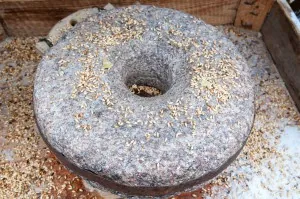
When most Americans think of “grains” we think of wheat, rice, and oats. For many of us, these three grains have played a big part in our daily diet for most of our lives. But times are changing and our reliance on these three grains as the foundation of our diet needs to change too. It isn’t that we need to stop eating these grains but that we need to start learning to diversify. From increasing rates of gluten intolerance to a rapidly expanding world population, it is becoming clear that the food of the future will need more than just these three grains to keep us all fed and healthy.
For many of us, the challenge is to figure out how to incorporate these ancient grains into our daily diet. Our lack of familiarity with the grains themselves paired with no experiential information on how to use them in recipes is making widespread adoption difficult. Get ahead of the curve with these tips for how to fill your family’s plates with these delicious, healthy ancient grains.
Amaranth
Amaranth, which comes from Mexico, provides protein, fiber, calcium, iron, manganese, and folate. It has a nutty flavor and can be cooked into porridge like oatmeal or ground into flour for use in bread, pasta, and other baked goods. Here are some great ways to use amaranth.
- Corn Amaranth Griddlecakes with Spicy Black Beans
- Amaranth Polenta with Wild Mushrooms
- Blueberry Amaranth Porridge
- Creamy Cannellini Bean Amaranth Soup with Basil
- Amaranth and Orange Bread (using a bread machine)
Buckwheat
Like several of the ancient “grains”, buckwheat is actually a seed that is packed with antioxidants, fiber, magnesium, manganese, zinc, and iron. It is also very versatile and can be toasted, roasted, or ground into flour for use as a replacement for wheat flour. Here are some ideas for using buckwheat at breakfast and beyond.
- Lentil and Buckwheat Salad
- Blueberry Buckwheat Pancakes
- Buckwheat Noodle Salad
- Buckwheat Potato Bread with Chile Honey
- Buckwheat Tabouli
Millet
Millet, which is thought to be the least allergenic of the cereal grains, offers a wide range of nutrients including protein, fiber, vitamin E, vitamin B, iron, magnesium, phosphorus, and potassium. It can be ground into flour, used as a cereal, and made into bread. Here are some ways you can use millet in your menu.
- Millet Muffins
- Stuffed Tomatoes
- Hot Millet Cereal
- Caribbean Chicken, Millet, and Mango Salsa
- Millet Linguine with Walnut and Basil Pesto
Quinoa
Quinoa is another seed commonly considered to be an ancient “grain”. It is packed with fiber, magnesium, and iron and can be used for baked goods, ground into flour, or eaten it its natural state like rice or corn. Here are some of the ways quinoa can fill your plate.
- Quinoa and Black Bean Salad
- Southwest Quinoa Vegetable Casserole
- Turkey and Quinoa Meatloaf
- Kale, Quinoa, and Avocado Salad
- Coconut Curried Lentil Stew with Quinoa
Related articles
- Get to Know these Neglected Grains (fillyourplate.org)
- Hey Kids! What’s Cooking? (fillyourplate.org)
- Pasta Primer (fillyourplate.org)
Crazy for Cranberries

It is the holiday season and it seems like everyone has gone crazy for cranberries. These small red berries, which grow on short shrubs and vines, are nutritious and delicious. While most of us are familiar with the sauce made from cranberries that is a staple of Thanksgiving dinner, the other ways that cranberries can enrich our lives during the holiday season may not be as familiar. Here is a look at the history of this small red superfruit and some great ways you can use it to brighten up your holiday season.
Cranberry 101
Cranberries are found in the cooler parts of Northern America and grow on very short shrubs or on long trailing vines. The shrubs rarely grow as tall as 1 foot but the vines can be as much as 7 feet long. They are often found in boggy areas. Cranberry plants have pink flowers with a distinctive shape which grow into white berries. As the berries ripen, they turn to the deep dark red color most commonly associated with them. Most commercially raised cranberries are made into juice, jam, and sauce but you may also be able to find fresh cranberries in the produce section of the supermarket during the holiday season.
Cranberries have a very tart flavor that may not be appealing to many people on its own. This is why cranberry juice is often sweetened or mixed with other juices to make a cocktail before sale. This makes it possible for people to get the health benefits of cranberries in a way that is still pleasing to their palette. Unfortunately, adding sugar to make cranberry juice more taste-bud friendly can also make it much less healthy than in its unsweetened form.
Raw cranberries are considered by some to be a superfruit because of their nutritional content. In a 3.5 oz serving there are 46 calories, 4.6 g of fiber, and a wide range of vitamins and minerals including vitamins A, B, E, C and K, manganese, iron, and magnesium. They are also a source of antioxidants which are believed to be beneficial for the cardiovascular system, to support the immune system, and to battle free-radicals that can cause cancer.
Holiday Uses
The most obvious way to use cranberries this holiday season is on your table. Almost every holiday meal goes great with cranberry sauce and if you are looking for a way to make your holiday meal a little tastier, try making your own cranberry sauce with one of these great recipes.
- Cosmo Cranberry Sauce
- Popping Cranberry Sauce
- Cinnamon Apple Cranberry Sauce
- Cranberry Orange Sauce
- Perfect Cranberry Sauce
Cranberries also make a great addition to baked goods. Try these scrumptious holiday recipes featuring the dark red orbs.
- Cranberry Pumpkin Bread
- Cranberry Orange Scones
- Oatmeal, Chocolate Chunk, and Cranberry Cookies
- Pear, Apple, and Cranberry Crisp
- Cranberry Harvest Muffins
In addition, cranberries also make a great addition to many other dishes.
- Jeweled Rice with Medjool Dates and Cranberries
- Farmer’s Favorite Salad
- Israeli Couscous with Apples, Cranberries, and Herbs
- Turkey and Cranberry Ravioli
- Chicken Salad and Cranberry Brie Toast
Related articles
- 4 Tips to Eat Right In The New Year (fillyourplate.org)
- How to Get Your Kids to Eat More Vegetables (fillyourplate.org)
- Where Can I get Farm-Fresh Vegetables Delivered Right to My Door? (fillyourplate.org)
Get to Know Your Leafy Greens
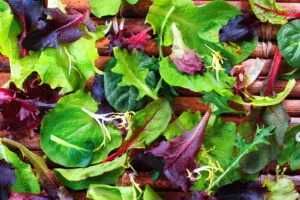
Yuma, Arizona is gearing up for the winter “leafy greens” growing season! This modest community in southern Arizona becomes widely known as the nation’s winter salad bowl from around November to March. That means that 90% of the nation’s vegetables for salads are grown right in Yuma, Arizona during the winter months. That makes Yuma County agriculture more than a $1.5 billion industry. Wow!
If there is one thing most of us could eat more of it is leafy greens. Packed with nutrition, these vegetables are at the core of a healthy diet. They provide a solid serving of fiber along with a healthy dose of vitamins and minerals. Incorporating more leafy greens can help protect you from things like heart disease, diabetes, and cancer. We find that one of main reasons people are not eating as many of these as they should is that a lot of us grew up on iceberg lettuce and carrots which means we aren’t always aware of all the options and we may not know how to use them. To help you get more leafy greens in your diet, here is some basic information about each of the most common types and some ways you can use them to fill your family’s plate.
Kale
No matter where you look these days, it seems like everyone is talking about kale. This leafy green that seems to have come out of nowhere is getting a lot of press because it is a powerhouse of nutrition including vitamins A, C, and K, folate, potassium, and even calcium. Kale can be used in salads, on sandwiches, and even baked into chips. It has a more bitter taste than some of the lighter lettuces and comes in a range of colors including purple, green, and even black.
Collard Greens
If you grew up in the South, you are likely familiar with these greens which offer similar nutritive value to kale but that have a different taste and texture. Collard greens have a cabbage-like flavor with a chewy texture. They make great replacements for tortillas or other wraps when making sandwiches because of their strong, wide leaves. They can be steamed, sautéed, and used in many of the same ways the other leafy greens are used.
Swiss Chard
This leafy green stands out from the others because of its brightly colored stalks and veins which can be red or come in a rainbow of colors. With a taste similar to beets, this leafy green is great in salads or when sautéed. It provides fiber and is a good source of vitamins A and C.
Spinach
There is a reason Popeye believed spinach would make him strong to the finish. It is full of folate, vitamins A and C, and is actually better for you when it is cooked, unlike many other leafy greens. It can be used in salads and on sandwiches or steamed, sautéed, or added to many different dishes.
Related articles
- 5 Easy Ways to Eat Better for Less (fillyourplate.org)
- Don’t Miss Out on the Root Vegetable Renaissance (fillyourplate.org)
- Little Known Facts About Lettuce (fillyourplate.org)
Figs, Fabulous Figs

The first week in November is National Fig Week which is a great opportunity to try this luscious and sweet fruit that offers some pretty fantastic health benefits. Whether you chose to eat them fresh or dried, figs are packed with nutrients. A single, medium sized fig provides fiber, potassium, manganese, and vitamin B6 for less than 40 calories.
History of Figs
Figs have been around for most of recorded history and are mentioned in the Bible and other ancient texts. Historians believe that figs have been a cultivated crop since as early as the 9th century BC and that they were a common staple in the diets of our ancient ancestors. In fact, the ancient Greeks so revered this fleshy fruits that they passed laws making it illegal to export them out of the country. Ancient Romans considered them to be sacred and a fig tree features prominently in the mythological story of Romulus and Remus, the twin brothers believed to be the founders of Rome.
As the ancient civilizations moved and spread out from the Mediterranean, figs followed, moving into Europe, Asia, and all the way to North America with the first Spanish settlers. Today, California is one of the largest global producers of figs.
Health Benefits of Figs
The common fig provides a good source of potassium which can help to control blood pressure. Research has shown that substituting foods that increase the potassium levels can have a positive impact on medical conditions like hypertension. Figs can also act as a good source of fiber. A single medium size fig provides almost 6% of the recommended amount of fiber for a single day. Because of their fiber content and calorie count, figs can be helpful in managing weight. Other research has shown that when women increase the amount of fruit fiber in their diet, they may be able to reduce their risk of breast cancer by more than 30%.
The health benefits of figs extend beyond just the fruits themselves. Fig leaves, which are seen throughout ancient art and architecture, are also edible and still feature significantly in the diets of other parts of the world. These leaves are believed to be helpful in managing diabetes and may even decrease the amount of insulin needed to manage diabetes.
Additionally, figs are a good source of both potassium and calcium which may help combat problems with bone density. The calcium they provide helps increase bone density while the potassium helps decrease the loss of calcium that occurs in those who eat a high-salt diet. Decreasing this loss of calcium helps prevent bone thinning.
Using Figs
Figs come in several different varieties and range in color from blackish-purple to greenish-yellow. They can be eaten raw or dried and make a great addition to many dishes. You can add some to your morning oatmeal or yogurt or use them to sweet any salad. Stuff them with goat cheese or cream cheese and the nut of your choice for a flavorful hors d’oeuvre.
Related articles
- 2 Small Steps to a Heart Healthier Diet (fillyourplate.org)
- How Eating a Clove of Garlic a Day Might Keep the Doctor Away (fillyourplate.org)
- Veggie Man Videos Tell Arizona Ag’s Specialty Crop Story With Educational Humor (fillyourplate.org)
4 Foods that Help Fight Cholesterol
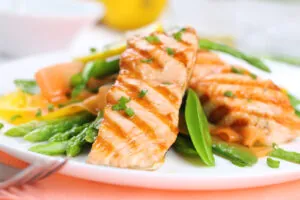
Heart disease, according to the Centers for Disease Control, is the leading cause of death in this country. The CDC indicates that more than 26 million Americans have been diagnosed with this condition which equates to more than 11% of the adult population. There are several risk factors that increase the likelihood of becoming one of that 11%, some, like genetics, that we can’t change, and others, like cholesterol, which we can. The American Heart Association says that while part of our overall cholesterol picture comes from our genes, we can impact the part that doesn’t by making some lifestyle adjustments and watching the food we eat.
While most experts agree that following a heart-healthy diet focused on fresh vegetables, fruits, whole grains, and “good” fats will help manage your cholesterol levels, there are also some foods that are powerhouses when it comes to lowering the amount of cholesterol in your blood. As part of National Cholesterol month, find ways to get more of these foods into your daily diet to help minimize your risk for high cholesterol and heart disease.
1. Soy
One of the most important dietary changes you can make to impact your cholesterol profile is to cut down on the amount of saturated fat in your diet. Soy products can help accomplish that goal by providing a good source of protein without adding a lot of saturated fat. Grab a serving of edamame as a snack instead of a chocolate bar to get more soy in your day.
2. Salmon
In addition to lowering your intake of saturated fat, research has shown that eating “good” fats can actually help lower your cholesterol too. One of these good fats is omega-3 fatty acids most commonly found in cold-water fish like salmon and tuna. Try Sweet and Spicy Salmon with Carrot, Leek, and Turnip Sauté using fresh Arizona vegetables.
3. Avocados
Another type of “good” fat is monounsaturated fat which helps boost good cholesterol and lower bad cholesterol. Avocados are a great source of this type of fat. Avocados also contain beta-sitosterol, a plant-based fat that helps reduce the amount of cholesterol absorbed into the bloodstream from the food we eat. You can mash them up to make guacamole, use slices on sandwiches and salads, or make a bowl of Tomato and Avocado Salad to take for lunch.
4. Beans
Another way to decrease your cholesterol using your diet is to increase the amount of soluble fiber you take in. Foods that are high is soluble fiber, like beans grown by Arizona Farmers, help decrease the amount of cholesterol your body absorbs which can lower your cholesterol. Try getting more beans in your daily diet by making some Corn and Black Bean Salsa with fresh Arizona-grown corn.
This month take action against heart disease by learning more about cholesterol. Check in with your doctor to see if you need to have your cholesterol checked and look for ways to add some of these great cholesterol-fighting foods into your family’s diet.
Related articles
- How Eating a Clove of Garlic a Day Might Help Keep the Doctor Away (fillyourplate.org)
- How to Eat Right While You Hike (fillyourplate.org)
- Blackberries: A Sweet and Healthy SuperFood (fillyourplate.org)
“Back to Basics” Nutrition Advice From Experts: Keep at Least Half of Your Grains Whole
 Editor’s Note: In the coming months Arizona Farm Bureau is finalizing a book regarding “Back to Basics” with nutrition and health advice from local nutritionists and other experts in the field. This article is an example of one of the chapters you’ll find when the book is released.
Editor’s Note: In the coming months Arizona Farm Bureau is finalizing a book regarding “Back to Basics” with nutrition and health advice from local nutritionists and other experts in the field. This article is an example of one of the chapters you’ll find when the book is released.
Family, Consumer, & Health Sciences Agent
U of A Pinal County Cooperative Extension
Whole Grain….what is a whole grain you ask? A whole grain is a grain that has been harvested but not processed. Processing is when important nutrients are removed from the grain and enriched. An enriched or refined grain has had nutrients such as iron and many B vitamins added back in after they are processed. A whole grain contains the entire grain kernel which consists of the bran, endosperm and the germ (Figure A) and keeps ALL the important nutrients.
Figure A
The bran section contains fiber. Fiber is very important in keeping our digestive tract regular (preventing constipation), it helps to control our blood sugar levels and lower blood cholesterol levels. The endosperm section contains the starch or carbohydrates. Carbohydrates are the energy or fuel source for our body and brain. The germ contains many B vitamins and protein. B vitamins such as folate or folic acid is especially important in child-bearing women to prevent birth defects such as spina bifida.
As you can see grains provide many important nutrients that our bodies need on a daily basis, but whole grains provide nutrients such as fiber which is not added back in after it is processed.
For most of human history we have eaten grains right off the plant stalk with minimal grinding, and when we did grind our grains we still ate every part. With the introduction of industrial roller mills in the late 19th century, the way we eat grains changed dramatically. This type of milling strips away the bran and germ making products made from grain easier to chew, digest, and easier to keep without refrigeration. The products (bread, pastries, etc.) that we can make from refined flour are fluffy and light, but we pay a price in terms of nutrition by losing more than half of wheat’s vitamin B, 90% of the vitamin E, and nearly all of the fiber.
It is very important that we try to make at least half of the grains we consume whole grains so that we receive more of the nutrients that grains have to offer. What does this mean? The recommended amount of grains for a person who is on a 2,000 calorie diet should be 6 ounces, which means 3 ounces of grains should be whole grains. But what is one ounce? The following examples equal one ounce of grains:
1 slice of bread
½ cup of cooked rice or pasta
1 cup of ready-to-eat cereal flakes
½ cup of cooked oatmeal
1 packet of instant oatmeal
1 small corn tortilla
3 cups of cooked popcorn
¼ large bagel
Since everyone is not on a 2,000 calorie diet our individual needs for grains will be different. The number of ounces of grains you should eat daily will depend on your daily calorie intake.
The grains food group consists of many, many foods we eat daily such as breads, pastas, tortillas, cereals, cookies, cakes, and the list goes on. How do you know you are eating a whole grain? By reading the ingredients label. When selecting whole grain products be sure to read the ingredients to determine if the product is a whole grain. One of the first ingredients listed should be a whole grain, such as whole wheat. Look for the ingredients whole wheat flour, bulgur, whole oats, whole-grain corn, or whole rye as one of the first ingredients on the label. Do not assume the word wheat on breads makes it a whole grain. Many brown breads are made with white flour and have coloring added in to give it the brown appearance. Read your labels carefully to determine if it is a whole grain. Another important item to look for is the fiber content on the nutrition facts label. If the product contains at least 3 grams of fiber per serving then the product is to be considered a good source of fiber.
There are many different ways to incorporate whole grains into our diets by making simple changes in the foods we already eat. For instance, do you like quesadillas? By simply buying whole wheat tortillas instead of tortillas made with refined flour you can get another whole grain into your diet. What about rice? Try substituting the whole grain quinoa for white rice. The following recipes offer some creative ways of adding whole grains into your diet, and believe it or not they are simple and yummy.
A frequent whole grain served for breakfast is cooked oatmeal. Here’s another healthy whole grain option.
Breakfast Quinoa
Ingredients:
- ½ cup uncooked quinoa
- ¾ cup skim milk
- 2 tablespoons water
- 1 tablespoon light brown sugar
- 1/8 teaspoon salt
- ¼ cup coconut, shredded
- 1 cup strawberries, sliced
- 1 cup bananas, sliced
Directions:
- Wash hands with warm water and soap.
- Rinse and drain quinoa thoroughly.
- Combine quinoa, milk, water, brown sugar and salt in medium saucepan. Bring to boil.
- Reduce heat and simmer about 10-15 minutes. Stirring occasionally.
- Pour immediately into 4 bowls and top each bowl with ¼ cup strawberries, ¼ cup bananas, and a spoonful of coconut. Serve warm.
Yield: 4 servings
This quick lunch option can also be made healthier by incorporating whole wheat tortillas instead of tortillas made with refined flour.
Black Bean & Corn Quesadilla
Ingredients:
- 1 cup canned black beans, drained and rinsed well
- 1 cup frozen or canned corn, drained
- ¼ cup prepared salsa
- 1 cup low-fat cheddar cheese
- 4 8” whole wheat tortillas
Directions:
- Wash hands with warm water and soap.
- Mix black beans, corn and salsa together in a bowl. Set aside.
- Lay tortilla on flat surface and spread tablespoon of black bean mixture on half of tortilla.
- Sprinkle ¼ cup cheese on top of bean mixture.
- Fold tortilla over and set on microwaveable plate.
- Microwave approximately 30 seconds (may vary by microwave temperature).
Yield: 4 servings
Quinoa can be substituted or become an added ingredient in many recipes that you already prepare, such as stews or chili, as in the following recipe:
Slow Cooker Quinoa Chili
Ingredients:
- 1 cup quinoa, rinsed
- 1 28-ounce can diced tomatoes (undrained)
- 1 14-ounce can diced tomatoes with green chilies (undrained)
- 1 16-ounce can black beans, drained and rinsed
- 1 15-ounce can corn, drained
- 1 15-ounce can kidney beans
- 2 cups low sodium chicken stock
- 1 large green bell pepper, seeded and chopped
- 1 onion, minced
- 1 teaspoon fresh garlic, minced
- 1 teaspoon cumin
- 1 teaspoon crushed red pepper
- 1 teaspoon chili powder
- Optional: Garnish with low fat cheese and/or low fat sour cream
Directions:
- Wash hands with warm water and soap.
- Place all ingredients in a 6 quart slow cooker and cook for 5 – 7 hours on low. Keep warm until ready to serve.
Yield: 8 servings
So now that you have had a hearty dinner of quinoa chili, what about dessert? You can prepare a delicious dessert that contains a whole grain, with very little cooking. A good example is this apple bread pudding.
Apple Bread Pudding
Ingredients:
- 2 cups fresh apples, peeled and sliced
- 2 slices 100% whole wheat bread, cut into 1” cubes
- 1 egg
- 1 tablespoon sugar
- 1 cup evaporated skim milk, canned
- 1 teaspoon vanilla extract
- ½ teaspoon ground cinnamon
Optional: ¼ cup raisins
Directions:
- Wash hands with warm water and soap.
- Preheat oven to 350 degrees.
- Lightly grease an 8” square baking dish.
- Combine apples, raisins (optional) and bread, pour into greased baking dish. Set aside.
- Beat egg and sugar in a medium bowl thoroughly. Gradually beat in milk.
- Stir in vanilla and cinnamon. Pour over bread mixture. Let stand about 30 minutes to soften bread.
- Place baking dish in a large pan. Pour enough hot water to fill the outside pan with about 1” of water.
- Bake about 30 minutes or until done. Serve warm or cool. Refrigerate leftovers.
Yield: 8 servings
Now that you have a few simple recipes that contain whole grains and were not hard to prepare or cook, let’s take a look at a whole grain snack food. Can you guess what it is? POPCORN….yes, popcorn is a whole grain and can be a healthy snack. When we air pop popcorn and do not add salt or butter we are eating a whole grain. Enjoy the popcorn, but limit the amount of salt and butter you add or try not adding any at all and instead sprinkle on a home-made pizza or ranch seasoning.
You can see that with a little creativity, making half our grains whole grains is not hard at all. By making a few simple exchanges we can get all the whole grains we need.
“Back to Basics” Nutrition Advice From Experts: Healthy Make and Takes
Editor’s Note: In the coming months Arizona Farm Bureau is finalizing a book regarding “Back to Basics” with nutrition and health advice from local nutritionists and other experts in the field. This article is an example of one of the chapters you’ll find when the book is released.
Family, Consumer, & Health Sciences Agent
U of A Pinal County Cooperative Extension
Healthy Make and Takes
One of the challenges many of us face is having to eat “on the run” between the many activities and events that fill our busy lives. What’s a person to do when you don’t have much time for meal preparation and you want to still eat something that’s healthy as well as delicious? And of course we want food that we eat on the run to be food that is simple to make as well. Included in this chapter is advice about what to pack so that your make and take meals are nutritious and recipes that are quick to make!
When packing food to go, keep portion size in mind. For most vegetables that would be 1 cup (about the size of a fist) and for fruit it would be a medium fruit (about the size of a baseball). It’s also important to remember some simple nutrition basics when you’re planning meals, whether they will be eaten at home around the dining room table or in the car, at your desk, etc.
The first nutrition basic is to make half of your plate / meal fruits and vegetables. One of the ways to make this simple to do is to prepare fresh vegetables ahead and put them into serving size plastic bags – that way all you have to do is to grab a few baggies (such as one with carrots, one with bite-size pieces of broccoli, and one with grapes) and you’ve got that part of your meal covered. Another way is to make sure your quick recipes include fruits and veggies.
Often when we’re trying to avoid fast foods, it’s because many of them are full of calories from fat or have too much sodium or added sugar. So the second nutrition basic is to keep calories that come from fat and sugar to a minimum, and don’t add a lot of salt to your recipes. Food can be very flavorful and not include a lot of fat, sugar, or salt. If you pack a salad, be very careful about using too much oil or oil-based dressing – a salad that has 0% of calories from fat can become over 50% calories from fat very quickly!
The third nutrition basic is to choose sources of lean protein, which includes not only lean cuts of meat and fish but also beans, nuts, legumes, etc. And keep serving size in mind – a 3-oz portion of meat or fish is one serving (about the size of a deck of cards) or ½ cup of dried beans or 2 tablespoons of peanut butter.
A fourth basic is to avoid sugary drinks and opt for water. You can flavor your own by adding lemon wedges, strawberries, or cucumber slices to a pitcher of water – you’ll enjoy the flavor and you won’t have those extra calories to worry about or sugar (sugar is what the bacteria in your mouth which cause tooth decay love to feed on!). Plus you’ll enjoy all of the health benefits of water!
And finally, when preparing and transporting food, be sure to follow good food safety practices!
- At the store (especially in the hot AZ summer) select cold foods last before you head to the register.
- For perishable foods, keep in mind you have a maximum of 2 hours (accumulated time) for perishable food to be out of the refrigerator; so if you pack perishables either go straight to your destination and put things in a fridge or make sure you’ve packed them in something that will keep them cold. And when the temperature is over 90°, your time limit is 1 hour out of refrigeration – so bring a cooler with a cold source.
- To prevent cross contamination, store meats, poultry, and seafood on the bottom shelf of the refrigerator to prevent juices from dripping onto other foods.
- Wash your hands before and after handling food, scrubbing vigorously for 20 seconds.
- Thaw frozen foods in the refrigerator (or in the microwave for immediate use).
- Wash all fruits and vegetables in cool running water; scrub with a brush if the produce is firm. That includes things like oranges because you don’t know what germs may be transferred to the orange sections in the process of peeling it.
- Discard any fresh produce that has been cut, peeled, or cooked after 2 hours at room temperature.
- Keep hot food hot and cold food cold.
If you’re having breakfast on the go, this quick meal can be made the night before, refrigerated, and warmed in the microwave before you leave the house – be sure to add the avocado, tomato, and salsa after you reheat. It’s a great choice because you have lean protein, low-fat dairy, whole grains, and veggies. Pair with a piece of fruit and you have all the food groups represented!
Breakfast Tortilla Wrap
Ingredients:
- 4 eggs (2 whole, 2 egg whites), cooked to your liking
- ¼ cup low-fat cheddar cheese, shredded
- 1 avocado, diced
- 1 tomato, diced
- 4 whole wheat tortillas
- Optional: Salsa
Directions:
- Wash hands with warm water and soap.
- Layer cooked eggs, cheese, avocado and tomato on tortilla.
- Wrap tightly. If desired, serve with salsa.
Yield: 4 servings
For another quick breakfast on the go, this Dress Up Yogurt recipe is ideal. When you choose the add-ins you control the amount of added sugar!
Dressed Up Yogurt
Ingredients:
- 16 ounces plain yogurt
- 1/4 cup Raspberry jam (or other fruit jam)
- 1 tablespoon honey
- 1/4 cup almonds, chopped
Directions:
- Wash hands with warm water and soap.
- Spoon yogurt into 4 separate bowls.
- Add jam, honey and chopped almonds.
- Stir to combine.
Yield: 4 servings
Wraps are a very popular alternative to sandwiches. If you’re using perishable foods in wraps or sandwiches, make sure you have something in the lunch bag that will keep the food cold. Also when choosing your wrap or any bread, to be sure it’s whole grain and not just colored with molasses, look at the fiber content – check the food label for 3 or more grams of fiber.
Pesto Chicken Rolls
Ingredients:
- 2 cups Rotisserie chicken, shredded, (or canned chicken, drained)
- 4 tablespoons Pesto, prepared
- 4 ounces sundried tomatoes, drained
- 1 cup Arugula lettuce
- 4 whole grain tortillas (or whole grain bread, wrap, lavosh, etc.)
Directions:
- Wash hands with warm water and soap.
- Spread one tablespoon of prepared Pesto on tortilla.
- Add ¼ cup sundried tomatoes on top of Pesto.
- Layer ¼ cup Arugula on top of sundried tomatoes.
- Roll tortillas and cut on bias.
Yield: 4 servings
Here is another lunch or dinner quick meal – you can let someone else do most of the cooking, but you can be the star by creating a great sandwich quick and easy. Add some veggies, a piece of fruit, and a cup of low-fat or fat-free milk for a balanced meal.
BBQ Chicken Sandwiches
Ingredients:
- 2 cups Rotisserie chicken, without skin, shredded
- ¼ cup prepared barbeque sauce
- 4 whole wheat sandwich rolls
Directions:
- Wash hands with warm water and soap.
- Using two forks, shred Rotisserie chicken, and place in a mixing bowl.
- Pour barbeque sauce over chicken and stir until well combined.
- Serve on a whole wheat bun.
Yield: 4 servings
This recipe is an example of how you can make something unexpected that is healthy and delicious. The combination of flavors is really great. Keeping the oil to a minimum keeps the calories in check too. For a fat-free alternative you can leave the oil out of this recipe.
Tomatoes & Peaches
Ingredients:
- 2 cups tomatoes, sliced and seeded
- 2 cups fresh peaches, sliced
- ½ cup red onion, thin sliced
- ½ cup cilantro, chopped (or other favorite herb)
- 2 teaspoons olive oil
- 2 teaspoons fresh lemon or lime juice
- Optional: salt and pepper, to taste
Directions:
- Wash hands with warm water and soap.
- Place seeded and sliced tomatoes, sliced peaches, thinly sliced red onion, and chopped cilantro in a mixing bowl.
- Whisk together olive oil and lemon/lime juice.
- Pour dressing over salad ingredients and mix well. If desired, add salt and pepper to taste.
Yield: 4 servings
Another great side for a make and take meal, this one includes some lean protein (the nuts) and fiber (celery is full of fiber), plus it packs a lot of flavor!
Stuffed Celery
Ingredients:
- 1 cup cashews
- 1 chili pepper, roughly chopped
- 1 clove garlic, chopped
- ¼ teaspoon soy sauce
- 2 -3 tablespoons water
- ½ cup cilantro, chopped
- 2 celery stalks, washed and cut in half
Directions:
- Wash hands with warm water and soap.
- Place cashews, chili pepper, garlic and soy sauce in a blender.
- Add water to moisten ingredients.
- Scoop blender ingredients into a mixing bowl.
- Fold in chopped cilantro.
- Fill celery pieces with mixture.
Yield: 4 servings
Want something more inspired than a piece of fruit? Try this recipe. You don’t need to add sugar to add sweetness to fresh fruit – just a little lemon juice will freshen the salad and keep fruits from turning brown.
Fresh Fruit Salad
Ingredients:
- 4 cups of any combination of fresh fruits, diced/sliced/balled
- 3 tablespoons fresh lemon juice
Directions:
- Wash hands with warm water and soap.
- Dice, slice or ball your favorite variety of fresh fruit.
- Toss with fresh lemon juice.
Yield: 4 servings
Looking for an easy dessert that’s also healthy? Try these cookie sandwiches. Don’t forget, though, that cream cheese is a dairy food and needs to be kept cool.
Ginger Snap Sandwich Cookies
Ingredients:
- 8 Ginger Snap cookies
- 1 tablespoon honey
- 1 tablespoon lemon zest
- 4 ounces low fat cream cheese
Directions:
- Wash hands with warm water and soap.
- In a mixing bowl, combine honey, lemon zest and cream cheese.
- Spread cream cheese mixture between 2 Ginger Snap cookies.
Yield: 4 servings
For more healthy meal ideas visit www.pinterest.com/MyPlateRecipes.
Get to Know these Neglected Grains
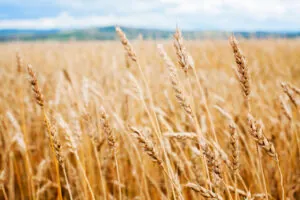
When was the last time you had some buckwheat bread? How about a millet muffin or a quinoa cupcake? In all likelihood, the answer to all of these is never. In fact, if you are like most Americans, you may not even recognize the names of these three traditional whole grains. The United Nations and the Food and Agriculture Organization (FAO) are hoping to change that as the world’s population edges toward 8 billion and food security becomes an even more critical global issue.
It can be hard for many Americans to understand the global concerns over food security. We are lucky to have the most productive farmers and ranchers in the world and most of us cannot remember a time when filling our plate required anything other than a trip to the local grocery store. But there are many people around the world who are not this lucky. Last year, according to the FAO, almost 900 million people or 1 out of every 8 people on the planet were undernourished. For these people, food security is a constant concern. As global organizations like the United Nations and the FAO look at future population projections paired with projected food production, they see a global crisis on the very near horizon.
In an effort to avert the anticipated problems with future food security around the world, the UN and the FAO are working to promote the adoption and cultivation of whole grains outside of the few that make up the majority of production today. The fear is that our overreliance on a few whole grains including wheat and rice poses significant risks to our ecosystem, food security, and the biodiversity of the crops we rely on to keep us fed. By promoting these lesser known whole grains, the organizations hope to diversify the base upon which the world’s food supply grows which will increase food production and security overall. Here are the “neglected” grains that the FAO encourages everyone to explore and adopt as part of the overall awareness program.
Amaranth
Amaranth comes from Mexico and was widely used by the Aztecs. It has a nutty flavor and provides protein, fiber, calcium, iron, manganese, and folate. It can be eaten on its own or ground into flour for use in bread, pasta, and other baked goods.
Buckwheat
Despite its name, buckwheat is not actually a type of wheat; it is a seed. Full of antioxidants, fiber, magnesium, manganese, zinc, and iron, it has a powerful nutritional profile. It can be toasted, roasted, or ground into flour for use as a replacement for wheat flour.
Millet
Millet is believed to be the first domesticated cereal grain and is still grown and used in many parts of the world. It offers a stellar nutritional profile, providing protein, fiber, vitamin E, vitamin B, iron, magnesium, phosphorus, and potassium. It can be ground into flour, used as a cereal, and made into bread. Another benefit of millet is that it is easily digestible and the least allergenic of the whole grains.
Quinoa
Another of the ancient grains, quinoa is actually a seed that comes from South America. It provides fiber, magnesium, and iron and can be used for baked goods, ground into flour, or eaten it its natural state like rice or corn.
Related articles
- Hey Kids! What’s Cooking? (fillyourplate.org)
- Pasta Primer (fillyourplate.org)
- How Sustainable is Our Food Supply? (fillyourplate.org)
Freekeh: What’s Old is New Once Again

This article originally appeared in the January/February 2013 issue of Foodie News, brought to you by the Public Relations Department of the American Farm Bureau Federation.
Freekeh, the newest grain-based product to hit the specialty food shelves, is catching the eye of consumers. But like many trends cropping up, freekeh is not as new as you would think.
Freekeh, an Aramaic term meaning “to rub,” has been around for close to 3,000 years, according to Thomasina Nista, executive vice president and CEO of Freekehlicious. The process was discovered when a Middle Eastern village came under fire and its wheat crop was damaged. The once-green crop was rubbed off the char and then cooked, creating freekeh.
“You don’t go out in the field and grow freekeh,” said Nista. “Freekeh can be made from any grain; our freekeh is made from durum wheat. You pick the wheat while it’s still young and green, so it’s retaining a lot of nutrients and vitamins that you normally don’t get in matured wheat.”
The rice-like dish has four times the fiber of brown rice and is also high in protein, calcium and prebiotic properties that are important for fueling the growth of healthy bacteria. Freekeh has a low Glycemic Index, which is important to diabetics. It is also low in carbohydrates.
Nista said freekeh is a very versatile dish. Her company offers two different products, whole grain and cracked, with preparation times ranging from 20 minutes to 45 minutes. She added storing it is the best part.
“The unique thing about it is that you can cook it on Sunday and put it in your refrigerator and it truly tastes just as good on Sunday as it will on the following Friday.”
Many people enjoy freekeh as a breakfast food, including kids, as it is served similar to oatmeal and can be topped with items such as honey, nuts and fruit. And because it is a resistant starch, Nista explained it keeps you fuller longer. She added that she enjoys preparing it with vegetables.
“I just went and bought broccoli rabe and I’ll cook up the broccoli rabe with garlic and oil and then I’ll just sprinkle in the freekeh. So no matter what vegetable I’m making, I just sprinkle it in and it just adds to it,” said Nista.
April 3 is the Whole Grains Council’s Sampling Day and Nista encourages consumers interested in trying freekeh to take part.
Freekeh is available online from Freekehlicious and at Whole Foods.


